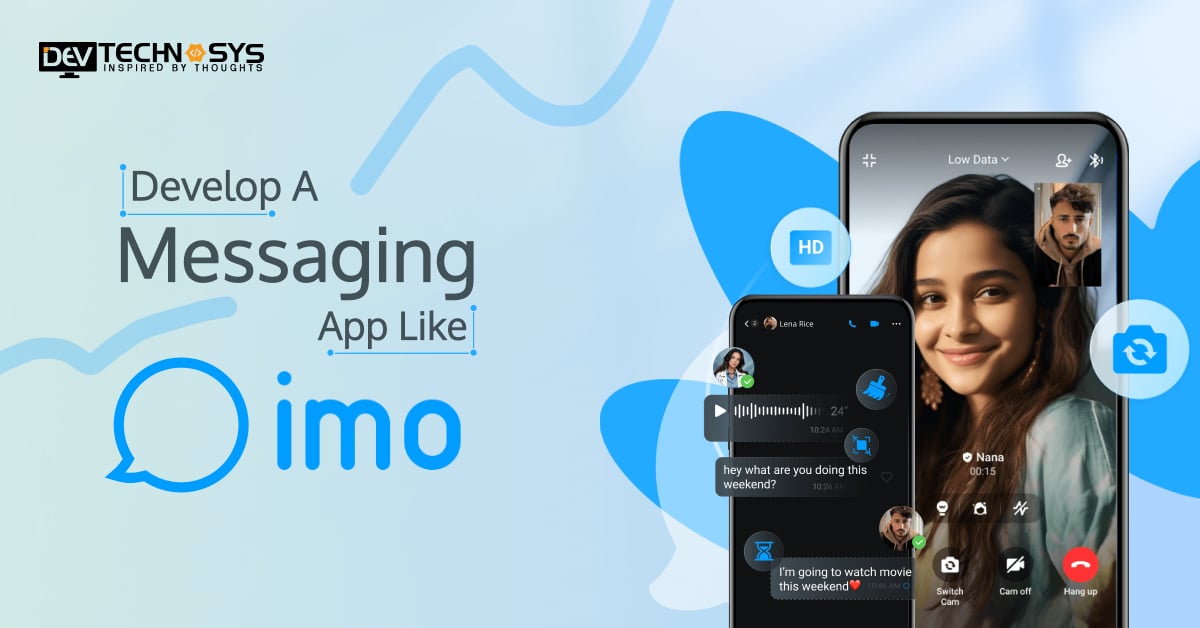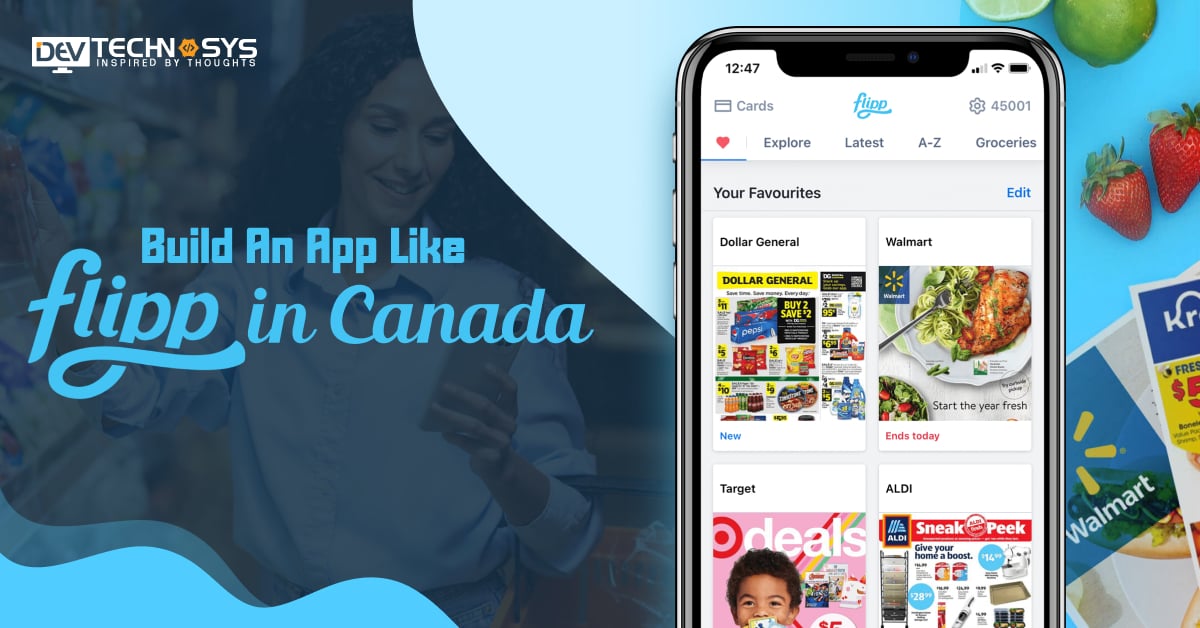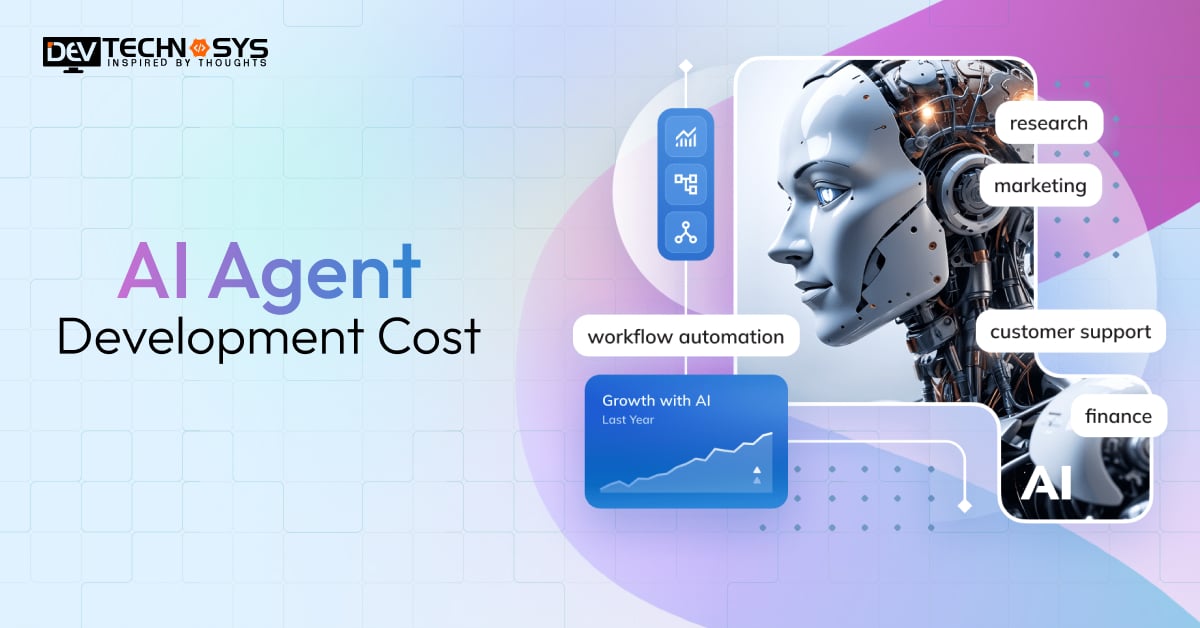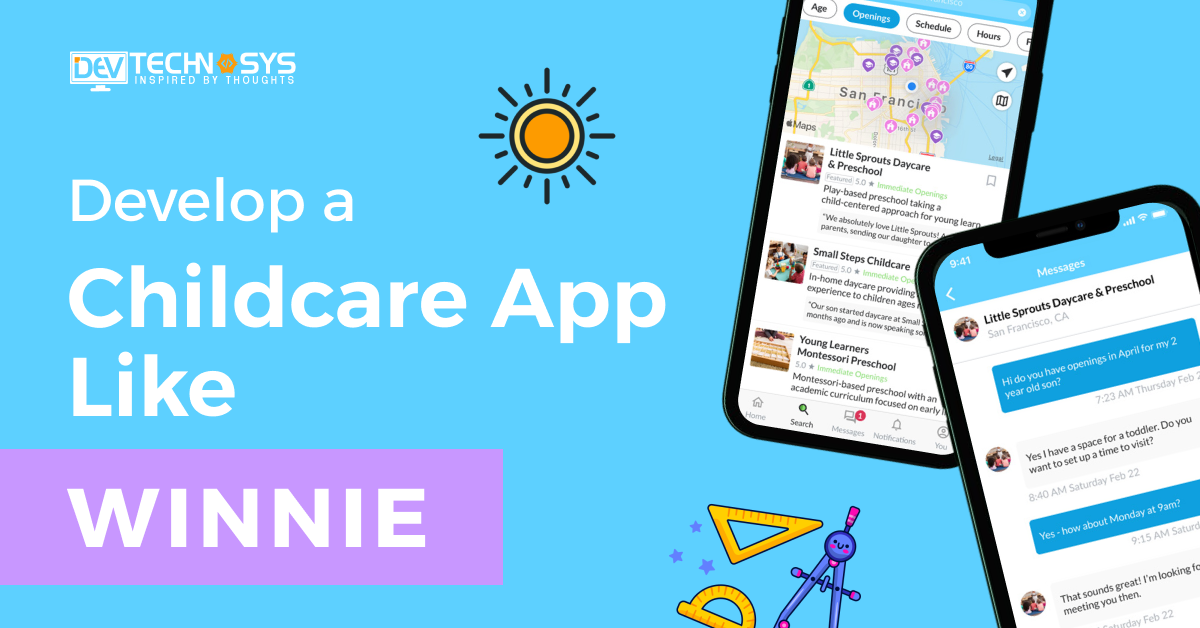“Global Messaging Made-Easy”
Want to make an awesome app like IMO?
Let’s go! First, think about what your app should do, like sending texts, making video calls, and sharing photos.
Then, ask some competent developers to help you build it.
You’ll need a cool design, fast servers, and strong security so people can chat safely. Make sure your app is easy to use, just like IMO.
As per the recent study , the worldwide messaging application market was worth $46.75 billion in 2024 and is anticipated to be worth $54.96 billion in 2025.
With good ideas, a great team, and hard work, you can develop a messaging app like IMO that people will love to use every day!
Start building today and connect the world your way!
What is IMO?
IMO is a free app for texting and video calling that lets people talk, write, and video chat over the internet. IMO or Verizon messaging app enables you to share video files, chat with other people, and use end-to-end security to keep your conversations safe. You can get IMO on Android, iOS, and the web. It’s popular because it’s easy to use, quick, and doesn’t use much data, which makes it great for places with slow internet.
- Voice & Video Calls
- Multimedia Sharing
- Status Updates
Market Stats of Global Messaging Applications
- The global messaging application market was valued at $46.75 billion in 2024 and is projected to reach $54.96 billion in 2025, according to a recent report.
- The market for messaging app APIs is projected to grow at a rate of 9% per year from 2025 to 2030, and it will hit USD 130.87 billion by 2030.
- With 8% of the market, North America led the chat app API market in 2024. This is because it has a very powerful technological system and a lot of people who use technology.
- The messaging application API market is growing due to A2P messaging, OTT media services, smart devices, and continuous internet access.
- As per the recent study, with a share of 0%, the open APIs group led the market in 2024.

Top 10 Messaging Apps Like IMO
10 best apps like Kik and IMO: Discover their downloads, user ratings, launch years, and platform availability to find the best alternatives for seamless communication and connectivity worldwide.
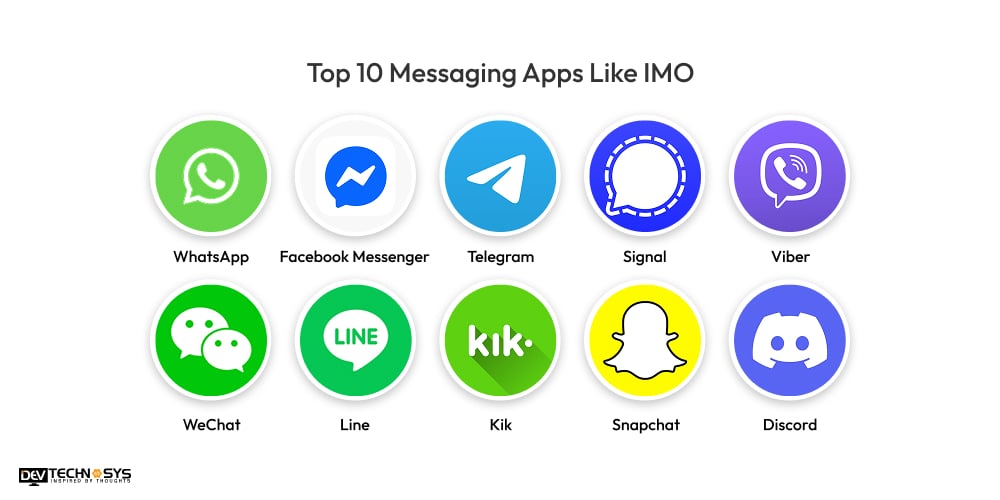
| App Name | Downloads | Ratings | Launched Year | Platform Availability |
| 5B+ | 4.3 | 2009 | Android, iOS, Web | |
| Facebook Messenger | 5B+ | 4.1 | 2011 | Android, iOS, Web |
| Telegram | 700M+ | 4.5 | 2013 | Android, iOS, Web |
| Signal | 500M+ | 4.5 | 2014 | Android, iOS, Web |
| Viber | 1B+ | 4.2 | 2010 | Android, iOS, Web |
| 1B+ | 4.3 | 2011 | Android, iOS, Web | |
| Line | 700M+ | 4.1 | 2011 | Android, iOS, Web |
| Kik | 300M+ | 4.0 | 2010 | Android, iOS |
| Snapchat | 1B+ | 4.3 | 2011 | Android, iOS |
| Discord | 500M+ | 4.6 | 2015 | Android, iOS, Web |
Why Businesses Want to Invest in Messaging App Development?
Message apps are becoming essential tools for communication in today’s fast-paced digital environment, making them a wise investment for businesses. Here are five important reasons why corporations want to invest in instant messaging app development:
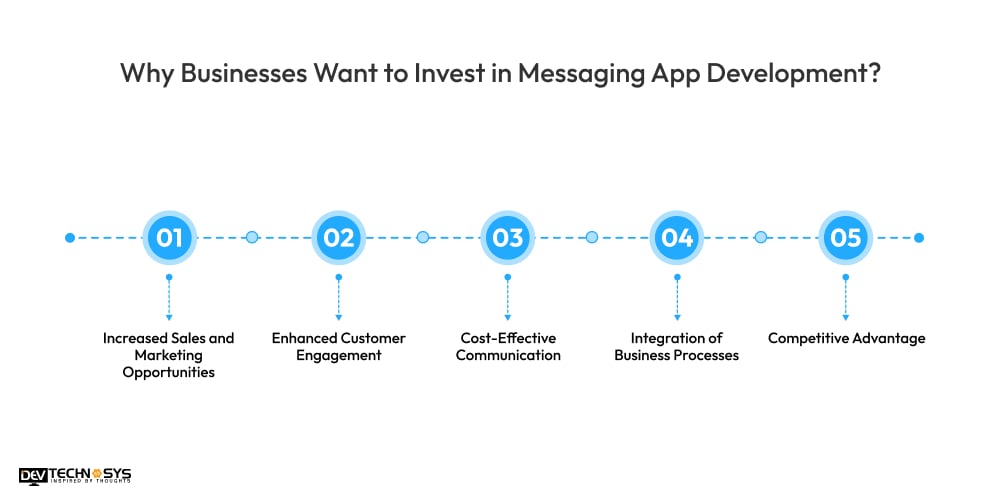
1. Increased Sales and Marketing Opportunities
Businesses that use integrated messaging may provide rapid assistance, promotions, and updates. IMO alternatives work as effective marketing tools, allowing businesses to push tailored offers, collect feedback, and nurture prospects, therefore increasing conversion rates and income.
2. Enhanced Customer Engagement
The entertainment app development solutions provide businesses a direct, real-time communication route to engage customers. Instant messaging promotes rapid answers, individualized conversations, and deeper customer relationships, which leads to loyalty and pleasure.
3. Cost-Effective Communication
Compared to regular phone calls and SMS, messaging applications use internet bandwidth to cut communication expenses. This is especially helpful for multinational enterprises, allowing them to access overseas consumers and staff without incurring costly fees.
4. Integration of Business Processes
If businesses or entrepreneurs build an app like KakaoTalk, it may integrate with CRM systems, chatbots, payment gateways, and other technologies. This simplifies operations, automates client service, and allows for smooth transactions, resulting in increased operational efficiency.
5. Competitive Advantage
Offering a branded messaging app improves a company’s digital presence and helps it stand out from the competition. It depicts the company as technologically competent and customer-centric, attracting tech-savvy people and cultivating brand loyalty.
How AI Can Improve the Messaging Apps Operations?
- AI-driven chatbots address consumer inquiries immediately, enhancing response time and user happiness without requiring human involvement.
- AI analyzes user behavior to suggest relevant stickers, emojis, or content, enhancing engagement and user experience.
- Artificial intelligence oversees conversations for unsuitable content, guaranteeing a secure and courteous atmosphere for all participants.
- AI detects unusual activity or potential threats, enhancing app security through proactive risk management.
- AI suggests words or phrases as users type, speeding up communication and making messaging more efficient.
7 Basic Steps to Develop a Messaging App Like IMO
Developing a messaging app like IMO involves strategic planning, selecting the right tech stack, designing a user-friendly interface, and building secure, real-time communication features. Adhere to these seven fundamental stages to develop a scalable, feature-laden messaging platform that people like. So, here we provide the IMO mobile app development process:
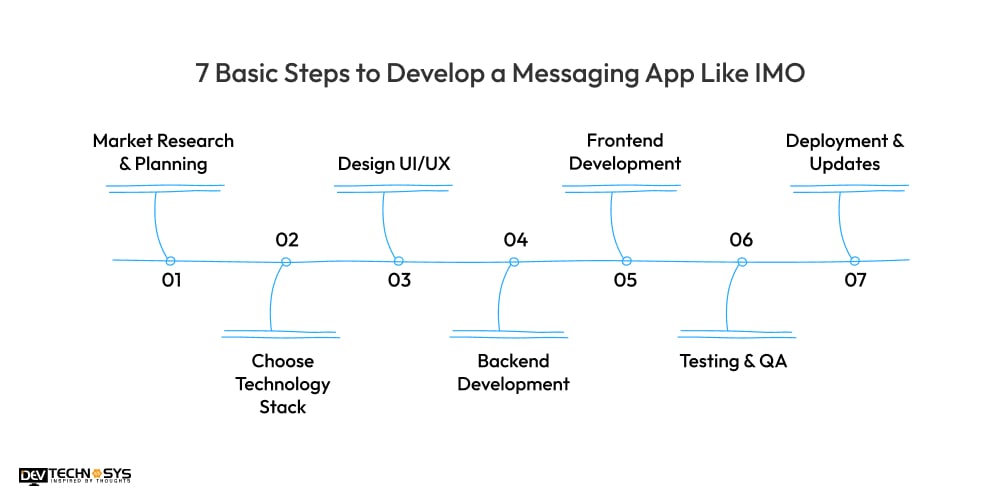
1. Market Research & Planning
To build an app like IMO, let’s look at what other apps are out there, what users want, and how the market is changing. Define your app’s goals, target audience, core features, and monetization strategy.
You should hire mobile app developers to oversee all development and make sure that your chat app solves real problems for users and stands out in a crowded market.
| What are the trends in the market right now? |
| In what ways do they compare to us? |
| What are customers saying about similar products? |
2. Choose Technology Stack
Moving to the second stage to develop an app like IMO, select appropriate technologies for frontend, backend, database, and real-time communication. For example, use Flutter or React Native for cross-platform apps, Node.js for backend, WebRTC for video calls, and Firebase or AWS for cloud storage, notifications, and database management.
| What type of app are we building (web, mobile, desktop)? |
| Do we want to make native or cross-platform apps for our phones? |
| What programming languages are our team familiar with? |
3. Design UI/UX
In the third stage to develop a messaging app like IMO, hire dedicated developers to create intuitive, user-friendly designs that support smooth navigation and engaging user experiences. Focus on simplicity, accessibility, and modern aesthetics.
Wireframes and prototypes should represent key features like messaging, voice/video calls, contact sync, and profile management for seamless user interaction.
| What devices will users access it from? |
| What colors and fonts should we use? |
| Is the design touch-friendly? |
4. Backend Development
Build a secure, scalable backend with features like user authentication, real-time messaging, multimedia sharing, data encryption, and contact syncing. Use protocols like WebSocket or MQTT for low-latency communication, and integrate cloud services for storage and server hosting.
| Which programming language/framework will we use? |
| Do we need a monolithic or microservices architecture? |
| How will different services communicate? |
5. Frontend Development
Develop client-side interfaces for iOS, Android, or web platforms. Implement responsive chat UI, contact lists, media sharing, video/audio call interfaces, and push notifications.
Hire a professional Android app development company to ensure smooth performance, minimal lag, and compatibility with various devices for a consistent user experience.
| Which frameworks or libraries will we use? |
| What is the preferred tech stack for UI development? |
| Are we building for performance, aesthetics, or both? |
6. Testing & QA
Connect to the sixth stage to create an app like IMO, conduct thorough testing, including unit, integration, UI, and load testing. Find and fix bugs, make sure speed is at its best, and keep data safe.
Simulate real-world scenarios to validate stability under high usage, ensuring your app is reliable before public release.
| What types of testing do we need (manual, automated, both)? |
| Do we have integration tests between systems/modules? |
| Does the app work across all target devices and browsers? |
7. Deployment & Updates
In the last stage to develop a messaging app like IMO, assemble skilled developers from an mobile app development company to launch the app on app stores with proper metadata and marketing assets. Keep an eye on data and user comments.
Fix bugs, improve speed, and add new features with frequent updates. This will ensure long-term growth and user retention.
| Which environments are we deploying to (dev, staging, production)? |
| What tools are we using (e.g., GitHub Actions, Jenkins)? |
| Do users need to install updates manually (for apps)? |
10 Core Features of Messaging Apps Like IMO
Messaging apps like IMO have transformed digital communication by offering fast, convenient, and interactive ways to connect. Here are the 10 core features that make these apps effective and widely adopted:
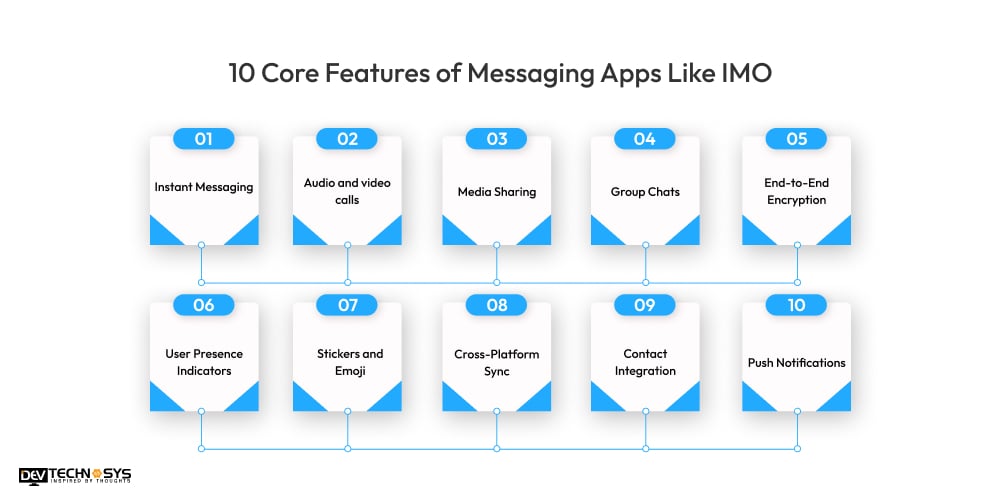
1. Instant Messaging
An app like WhatsApp enables users to send and receive messages instantaneously, with delivery and read receipts.
2. Audio and video calls
IMO clone apps allow users to interact face-to-face or by voice from any location, frequently with minimum data use.
3. Media Sharing
Users may transmit photos, videos, documents, and audio snippets to improve the depth and efficacy of their talks.
4. Group Chats
Group messaging enables numerous users to participate at the same time, making it excellent for communication among family, friends, and teams.
5. End-to-End Encryption
IMO clone apps offers end-to-end encryption that ensures the communications and calls are secret and only accessible by the sender and receiver.
6. User Presence Indicators
Status indicators (online, offline, typing…) inform users about the availability and activity of their connections.
7. Stickers and Emoji
The app similar to IMO, providing Emojis and stickers as examples of fun and expressive visual content that improve user engagement and conversation tone.
8. Cross-Platform Sync
IMO alternatives allow users to continue discussions from anywhere, thanks to seamless synchronization across platforms (mobile, web, and desktop).
9. Contact Integration
Automatic synchronization with the phone’s contact list makes it simple to locate and communicate with other users.
10. Push Notifications
An app like Telegram provides instant notifications to notify users of fresh messages or phone calls even while the app is not open.
How Much Does it Cost to Develop a Messaging App Like IMO?
The cost to build a messaging app like IMO anywhere from $8,000 to $25,000 to produce, with the exact amount depending on factors like functionality, design complexity, location, platform (iOS, Android, or both), and development costs. Basic apps with messaging and voice/video calls fall on the lower end, while apps with real-time sync, encryption, and cross-platform support increase the messaging app development cost.
Recurring expenditures like as server maintenance, upgrades, and customer support must also be taken into account. Hiring experienced developers or an agency can ensure better quality and scalability for long-term success.
| Messaging App Development | Estimated Cost | Time Frame |
| Normal App Development | $8000 – $12000 | 2 to 6 Months |
| Mid-Complex App Development | $14000 – $19000 | 6 to 8 Months |
| High-Complex App Development | $25000+ | 9+ Months |
What Are the Factors That Can Affect the Messaging App Development Cost?
Key Factors Influencing Messaging App Development Cost: Explore how features, platform choice, design complexity, development team location, security requirements, backend infrastructure, and ongoing maintenance collectively impact the overall budget and timeline for building a messaging app like IMO.
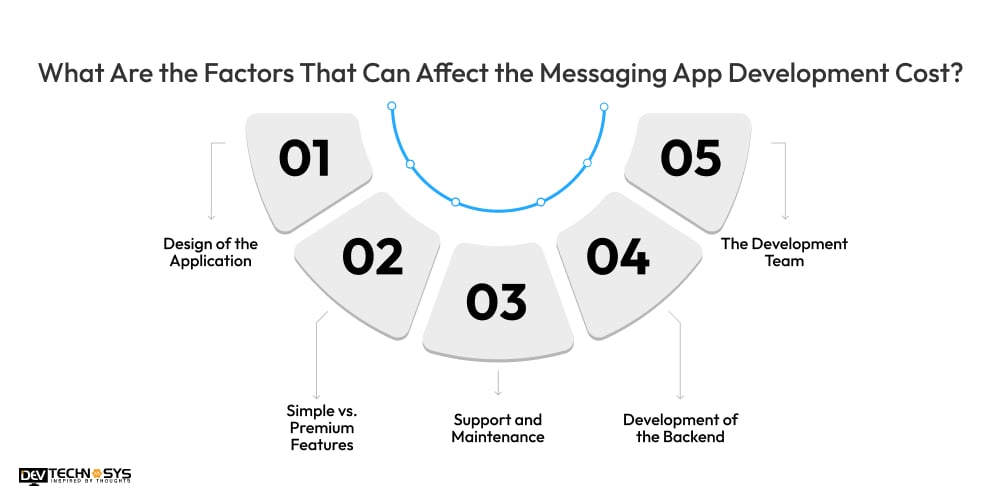
1. Design of the Application
The design of a messaging app has a significant influence on development costs. A basic, clean interface is less expensive, but bespoke animations, complex UI/UX features, and various screen designs demand more effort and skill.
Investing in a user-friendly, visually appealing design boosts user engagement while increasing the total mobile app development cost.
| Design Complexity | Estimated Cost (USD) | Description |
| Basic UI/UX | $3,000 – $5,000 | Simple layouts, minimal animations |
| Intermediate Design | $5,000 – $8,000 | Custom UI elements, interactive features |
| Advanced/Premium Design | $10,000 – $14,000+ | Complex animations, branded experiences |
2. Simple vs. Premium Features
Basic message and calling functions are less costly to create. However, adding premium features such as end-to-end encryption, file sharing, group calls, stickers, and chatbots raises IMO app development cost.
As features get more sophisticated, development time increases, and prices escalate due to the greater demands for coding, testing, and integration.
| Feature Set | Estimated Cost (USD) | Description |
| Basic Features | $4,000 – $8,000 | Text messaging, voice calls, contact sync |
| Premium Features | $8,000 – $12,000 | Video calls, encryption, file sharing, chatbots |
3. Support and Maintenance
Post-launch support and maintenance are continuing expenses that impact the overall IMO app development cost. Regular updates, bug patches, server maintenance, and adjusting to new operating system versions all necessitate the use of dedicated resources.
Investing in continual support assures app stability, security, and user delight, but it must be considered as a long-term expenditure.
| Maintenance Level | Estimated Annual Cost (USD) | Description |
| Basic Support | $3,000 – $6,000 | Minor bug fixes, updates |
| Standard Maintenance | $6,000 – $10,000 | Regular updates, security patches |
| Comprehensive Support | $10,000 – $15,000+ | Continuous monitoring, feature updates |
4. Development of the Backend
Backend development include server configuration, database administration, real-time communications protocols, and security measures. A scalable and dependable backend infrastructure is required, but it may be difficult and expensive.
The cost of using cloud services vs bespoke servers is further influenced by the necessity for APIs and interaction with third-party services.
| Backend Complexity | Estimated Annual Cost (USD) | Description |
| Simple Backend | $5,000 – $8,000 | Minor bug fixes, updates |
| Moderate Backend | $8,000 – $14,000 | Regular updates, security patches |
| Complex Backend | $14,000 – $18,000+ | Continuous monitoring, feature updates |
5. The Development Team
The number, expertise, and location of the development team significantly impact costs. Hiring experienced developers from higher-wage countries increases social media app development cost, whereas offshore teams may save money but present communication issues.
A well-balanced team of designers, developers, testers, and project managers is essential for ensuring timely and high-quality delivery.
| Team Type | Estimated Annual Cost (USD) | Description |
| Small Offshore Team | $8,000 – $12,000 | Few developers, lower hourly rates |
| Mid-sized Team | $13,000 – $17,000 | Balanced skill set and communication |
| Large/Expert Team | $18,000 – $22,000+ | Experienced developers, project managers, and QA |
5 Money-Making Strategies of Messaging App Like IMO
IMO alternatives have become essential communication tools worldwide, and monetizing them effectively is key to sustainability and growth. Below are five prevalent income techniques employed by these applications:
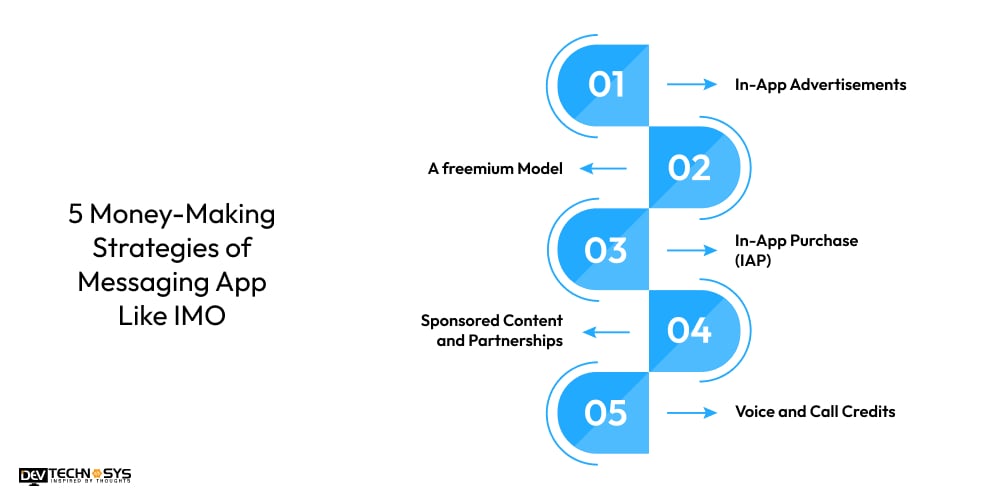
1. In-App Advertisements
One of the most prevalent monetization ways is to display advertising within the app. These can include banner advertisements, video commercials, and interstitial ads that appear between chats or while using the app.
Targeted advertising based on user data boost engagement and income. While successful, this strategy must strike a balance between user pleasure and inconvenience.
2. A freemium Model
Many chatbot development solutions provide a free basic version with fundamental functions and monetize through paid upgrades. Premium plans may provide better privacy, increased file sharing restrictions, bespoke themes, or exclusive stickers and emojis.
This strategy encourages consumers to pay for additional features without affecting basic functionality.
3. In-App Purchase (IAP)
Selling digital items within the app, such as stickers, GIFs, emoticons, or virtual presents, generates a consistent revenue source. Users like customizing their messages, while developers gain from the ongoing microtransactions.
This strategy works effectively when smoothly incorporated into the conversation experience.
4. Sponsored Content and Partnerships
If businesses create a mobile app like IMO, it may work with marketers to provide sponsored stickers, branded chatbots, and promotional campaigns. These collaborations may increase brand recognition and income while preserving the user experience.
5. Voice and Call Credits
The app similar to IMO offer selling call credits or subscription plans is a feasible income stream for applications that allow users to call conventional phone numbers (rather than only app-to-app). This pay-as-you-go strategy produces revenue from call usage in addition to free app features.
Conclusion
Finally, making a popular messaging app like IMO needs a lot of planning. From picking the right technology stack to making an easy-to-use UI/UX and a strong server system, there are many things that need to be thought out. Collaborating with a seasoned messaging app development company ensures that your application is secure, scalable, and replete with valuable functionalities. You can make a competitive app that meets user wants by focusing on core features like voice/video calls, real-time texting, and user privacy.
Frequently Asked Questions
Q1. How Much Does It Cost To Develop a Messaging App Like IMO?
The cost to build a messaging app like IMO is around $8,000 and $25,000, depending on features, platforms, design complexity, and development team location, with additional expenses for maintenance, updates, and server infrastructure.
Q2. How Much Time Does It Take to Create a Messaging App Like IMO?
To create a messaging app like IMO typically takes 3 to 6 months, depending on feature complexity, platform choice, design requirements, and team expertise, with more advanced functionalities requiring additional development and testing time.
Q3. What Third-Party APIs or SDKs Can Accelerate Development?
Third-party APIs and SDKs like Twilio, Firebase, Agora, SendBird, and Vonage accelerate messaging app development by providing ready-made solutions for real-time chat, voice/video calls, push notifications, user authentication, and scalable backend infrastructure.
Q4. What Marketing Strategies Help Launch and Grow a IMO Clone App?
Effective marketing strategies include social media campaigns, influencer partnerships, app store optimization (ASO), referral programs, targeted ads, content marketing, and community engagement to increase visibility, user acquisition, and retention for a messaging app launch and growth.
Q5. What Type of Technologies Are Used to Make a Messaging App Like IMO?
There are several technologies used to make a messaging app like IMO, such as React Native or Swift/Kotlin for the frontend, Node.js or Python for the backend, WebSocket for real-time messaging, Firebase or AWS for cloud services, and encryption protocols like TLS for secure communication in messaging apps like IMO.
